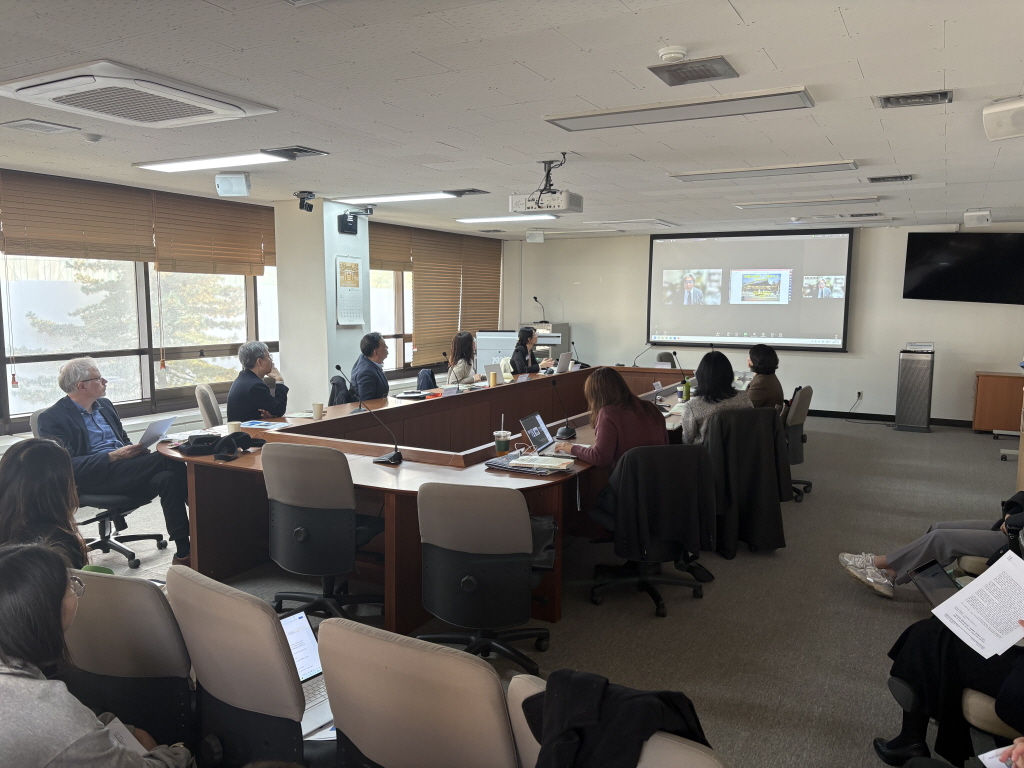[News] The 18th Kyujanggak International Symposium on Korean Studies

“Asians in Ancient Korea, Koreans in Ancient Asia”
Exchange and Cooperation in the Asian World Program – Panel Session Report
At the 18th Kyujanggak International Symposium on Korean Studies on November 6, 2025, a panel organized by the Exchange and Cooperation in the Asian World Program at SNUAC presented new research on interactions between the Korean Peninsula and other regions of Asia in antiquity. The panel brought together diverse topics that illuminate patterns of movement, exchange, and cultural entanglement across the region.
The first presenter, Jiseon Han, examined the structure and grave goods of the stone-chamber tombs at the Gamildong site in Hanam, dating to the 4th–5th centuries. Through an analysis of tomb architecture and excavated artifacts, she identified strong connections with Chinese cultural traditions. She argued that the architectural lineage of these stone chambers corresponds to those in the Lelang and Daifang regions, while grave goods such as metal ornaments and a celadon hu vessel suggest the deceased maintained close ties with the Six Dynasties cultural sphere. She concluded that the hybrid features of the Gamildong site—reflecting both commandery-system elements and Chinese cultural forms—demonstrate how foreign migrants were incorporated into the Baekje central polity.
The second presenter, Sujin Kim, focused on the activities of second-generation Goguryeo émigrés active during the Kaiyuan and Tianbao eras under Emperor Xuanzong of Tang (early–mid 8th century). Centering on Wang Mozhong, Wang Sare, and Gao Xianzhi—figures whose biographies appear in the Old Tang History and New Tang History—she examined how these individuals, many active around the time of the An Lushan Rebellion, exercised direct influence at the core of Tang political and military power. By tracing their roles, she sought to shed light on Xuanzong’s accession as well as the dynamics before and after the rebellion. She emphasized that further research is needed on the networks among Goguryeo-origin officials and between Goguryeo and Baekje émigré communities within Tang military institutions.
The third presenter, Jihyun Park, compared the migration patterns of Baekje-origin settlers in Japan, distinguishing between general migrants (toraein/dōraijin) and exiled Baekje refugees. She first reviewed conceptual issues surrounding the term “migration,” noting the lack of scholarly consensus on its definition. She then compared the two groups in terms of migration motives, group characteristics, degree of settlement, and local perceptions. She argued that exiled Baekje migrants, as forced migrants who settled permanently and often faced negative attitudes from host communities, developed stronger internal cohesion and proactively sought to establish new lives.
The fourth presenter, Yamada Kunikazu, discussed immigrant groups (toraein) and continental cultural transmission in ancient Kyoto. He explained that during the Kofun period (late 3rd to early 7th century), a large number of groups from China and the Korean Peninsula migrated to the Japanese archipelago. These groups, while centered on people from the East Asian mainland, also included local Wa individuals who entered the groups through marriage or quasi-kinship contracts. Drawing on texts such as the Nihon shoki, alongside archaeological evidence from keyhole tomb clusters and hydrological facilities, he provided an overview of the activities of toraein communities in Japan, focusing especially on the Hata clan, one of the most prominent immigrant lineages.
During the general discussion, scholars emphasized the importance of interdisciplinary research on migration in ancient Northeast Asia. They cautioned against interpreting ancient Asia through the framework of modern nation-states—Korea, China, and Japan—and stressed that cultural transmission did not flow unidirectionally from China to Korea and Korea to Japan.
Participants also noted the need to distinguish between migrant groups that maintained strong networks with their places of origin and those that did not. Another key question raised was when, and under what conditions, migrants cease to be considered “migrants.” Finally, discussants highlighted that the category of yumin (displaced people) is inherently complex. In textual sources, yumin often reflects a strong awareness of having belonged to a fallen state, indicating that psychological and cultural conditions are as significant as physical displacement.
